By Darryl Van Rhey (1999)
“While some artists have never questioned the current marginal and passive status of art and are content to work within the reservation called the ‘art world,’ others have made conscious attempts over the last decade to combat the relentless commodification of their products and to reenter the ‘outside world.’ In the late ’60s, after a period in which most avant-garde art was drastically divorced from social subjects or effects, many artists became disgusted with the star system and the narrowness of formal ‘movements.’ They began to ask themselves larger questions. When they looked up from their canvas and steel, they saw politics, nature, history and myth out there.”
Lucy Lippard, Overlay (1983)
Avant-garde movements have historically originated among groups of artists whose work is devoted to new and experimental concepts that subvert institutional values. Such values are said to be marked by a concern for material interest and respectability, which inhibits expression. Any such regime, it’s held, is devoted to the status quo, to the preservation of appearances, and inevitably engenders an insincere and stultifying mediocrity of taste. It is the duty of the artist, as a member of a renegade class situated at the fringe of society, to challenge these philistine standards, thereby reclaiming the practice of art as a spiritual enterprise.
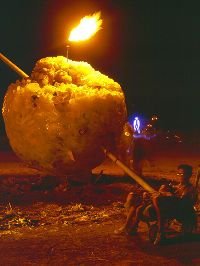
Judged by this standard, the avant-garde, in this latter part of the 20th Century, no longer appears to exist. Attempts to shock the middle class undoubtedly persist, but these actions, like so many other cultural elements of our contemporary scene, have been smoothly co-opted by a process of commodification. Madonna now affronts the bourgeoisie, as surely as Piss Christ and the concoctions of Jeff Koons, but such transgressive gestures are themselves merely artifacts of a marketing process. They do nothing to disturb the course of material interest, much less lead to any form of spiritual awakening. Art in America now originates within a system that is wholly institutionalized. The dead hand of bureaucracy is everywhere apparent, represented by a system of production which links art schools to an art industry — a complex of corporations, museums, and private dealers — that, in turn, controls the marketing apparatus that selects and distributes these privileged goods. Caught between the aridity of academia and the banality of this marketplace, it scarcely seems surprising that our art has lost vitality.
One minor chink remains, however, in the armor plating of this system, and it is found in the necessary concession that is made to “outsider” art. This novel category identifies art that is produced outside of the established system. It is, in practice, an extremely broad concept, including work produced within the unselfconscious vernacular traditions of folk art, “naive” work created by amateur or untrained artists, and contemporary popular productions, such as custom car decoration or graffiti art. These artists and their styles, once discovered by critics and academics, are appropriately bracketed by theoretic formulations and historical analysis. Transformed into a kind of intellectual property, this work becomes “art”, and may then assume the status of commodity within a market for “significant” work. That art might thrive, or even be said to exist, beyond the context of this system remains a moot point.
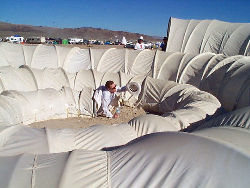
Nearly all of the art produced at Burning Man readily falls into the category of outsider art. Or rather, it fulfills the first requirement for inclusion in this category. It is frequently produced by unschooled amateurs who have little acquaintance with academic discourse. It is a “lay” art made popularly accessible to an ingenuous public. It has, to date, received only modest critical validation and it possesses little currency within the conventional marketplace. The work of many “serious” artists, who have exhibited their work in legitimating venues,
and who have devoted themselves over many years to their craft and calling, is certainly present in abundance at Burning Man. However, much of this work is burned in the course of the event and, most significantly, it is deliberately stripped of its normal marketplace context. The art of Burning Man, produced by amateur and professional alike, is created within and for a community, and, within this community, it is intended to be given away. This is work that’s generated by a way of life. It is an art, above all other things, that is devoted to social connection and, to understand its peculiar character, we must first consider how it is produced and the setting in which it is presented.
The social and economic world of Burning Man is created by gift giving. This forms a contrast to the “economy of scarcity” that prevails within the art world at large, in which a ceaseless competition for resources and recognition inevitably alienates artists from one another. The audience for art at Burning Man is superabundant, the venue represented by the open playa is virtually limitless, and acceptance of any work, regardless of accreditation, is unconditional. Moreover, these remarkable freedoms are counter-balanced by a disciplining challenge. The celebrated doctrine of “radical self-reliance,” by which participants are vested with complete responsibility for creating their personal visions within a severe natural environment, promotes a high degree of collaboration. Artists are simultaneously freed from their dependence on a validating system that controls their work and perpetually urged, as they assemble their resources, toward cooperation with others. This process, in fact, is directly abetted by the Burning Man Project. Utilizing the abundant resources of the Internet, it is possible to provide artists with a ready supply of volunteer aid. Furthermore, both the Burning Man event and the interconnective network formed by the Internet have been used to expose the work of artists to a larger and far more diverse public than is currently accessible within the self-limiting subculture formed by the established art world. It becomes possible for artists to directly market their work to interested individuals, thereby subverting the current marketplace system altogether. Burning Man, as a populist movement, has exposed thousands of participants to the uses of art who would otherwise be excluded by the social and economic constraints that currently oppress its practice.
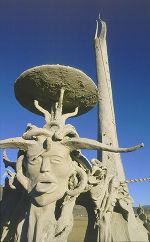
The next phase of this process occurs in the desert. From its inception, Burning Man has encouraged interactive strategies of presentation. This is art, to paraphrase project founder Larry Harvey, that convenes society around the creative act. Participants in Burning Man are urged to literally lead la vie Boheme — to struggle at the edge of physical survival while giving everything for self-expression. The interior gifts that constitute the artist’s talent become a currency of social exchange. Art at Burning Man does not merely attempt to break down barriers between audience and art form, and between creator and participant — a long-standing aim of avant-garde movements in our century. It seeks to become the central principle that generates both social interaction and the ordering architecture of civic space.
The result of this emphasis on the socially generative aspects of art has produced work that is marked by certain themes and expressive techniques. At a practical level, much of this art requires an action on the part of participants to achieve completion. It is often premised on fantasies and participatory scenarios which seduce the erstwhile audience for art into assuming an active and interpretive role that often places them in a relationship with fellow participants. This principle is most immediately evident in what are called “Theme Camps”. These live-in interactive installations have multiplied in recent years until they now line the main street of Black Rock City, extending in an uninterrupted series over more than one linear mile of civic real estate. Almost as prevalent are art-based conveyances. A city-wide ban on motorized vehicles allows but one exception: mobile art. This has led to the proliferation of many ingenious devices, ranging from elaborately decorated “Art Cars” to motorized couches, chairs and lamp stands. As radically accessible and self-created worlds, these installations bear a remarkable resemblance to web sites on the Internet. The image of the desert as an anologue of cyberspace — as an interactive, spontaneous and anti-hierarchic medium — has profoundly affected the aesthetic of Burning Man.
Furthermore, these strategies of engagement and interaction have deeply influenced the work of the many professional artists who contribute to the event. A monumental ice ball entitled Temporal Decomposition was fashioned at Burning Man 1997 by artist Jim Mason. This solid sphere, measuring 11 feet in diameter, represented a complex meditation on the processes of time. Embedded with an array of clocks and watches, it functioned, in concert with four frozen obelisks, as an enormous sundial. Gradually melting over a span of five days, this frozen mass embodied geologic process, evoking Time’s passage as a medium of transformation. Sited at a public crossroads, it invited parched participants to rub against it and consume its substance in the form of flavored snow cones. This same year saw the installation of Das Ammoniten Projekt, a metal and canvas structure by German artist Hendrik Hackl. Measuring 10-feet-high and 70 feet in diameter, this sculpture was fashioned in the semblance of a giant ammonite. Participants were allowed to enter this coiled construction, creeping forward by degrees until they slithered out a narrow aperture located at its center.
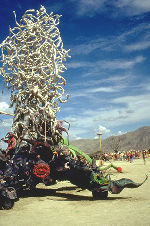
An equally participatory work by Dan Das Mann, installed in 1998, took the form of a 25-foot-tall tree constructed from copper pipes. Titled The One Tree, it simultaneously spouted fire, water and steam from its branches. It soon became a community bathing spa. In 1996 a large-scale assemblage was constructed from 88 pianos by artist Steve Heck. The Piano Bell enabled participants to generate sounds by stroking the strings of exposed instruments. Another interactive work, conceived by Larry Harvey, designed by sculptor Michael Christian and equipped by Dr. Aaron Wolf Baum with an interactive sound system, appeared in 1998. The Nebulous Entity functioned as an interactive performance platform designed for mobility. The 30-foot-tall sculpture was outfitted with five airplane wheels attached to supporting armatures, allowing participants to push it across the desert floor. Moving mysteriously through the night, it recruited involvement, generating spontaneous processions throughout the city.
Certain other techniques and thematic preoccupations also characterize the body of work Burning Man has produced, and these can be divided into basic genres. The first of these categories relates to the practice of appropriation. From an early date, Burning Man has been influenced by San Francisco’s machine art underground, a movement pioneered by Mark Pauline’s Survival Research Laboratories throughout the 80’s and 90’s. In recent years, many of its members have formed independent groups whose work appears at the festival. Notable practitioners include Kal Spelletich of the SEEMEN and industrial artist Christian Ristow. Appropriation is a central tenet of this work. Industrial technology is excerpted from its functional context and converted to a wholly aesthetic, and often spectacularly destructive, purpose. The work of Spelletich, Ristow and others will be featured this year at Burning Man at a “disassembly line” located at 9 o’clock upon the Wheel of Time. These practices form part of a specifically postmodern aesthetic, a willful deconstruction of the economic and industrial apparatus which carthartically redeems these tools for expressive use. A prime example is a performance installation entitled HELCO, which formed part of Burning Man’s annual themed art pageant in 1996.
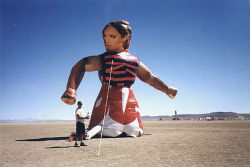
This performance featured the work of both Spelletich and Ristow and was conceived as a broad burlesque upon the themes of mass production and consumption. The elaborately premised drama transformed participating members of the public into “souls” within a quarter-mile-long model of Dante’s Inferno. This same grotesque sensibility is apparent in The Sta-Puft Lady, produced for the event by Tim Kaulen. This huge inflated plastic doll was constructed from discarded advertising signage and tethered to the desert floor. Bloated, dismembered and unnervingly cute, this 20-foot deformity loomed over the event in 1997, like some ur-monster gleaned from Goya’s late and dark imaginings.

